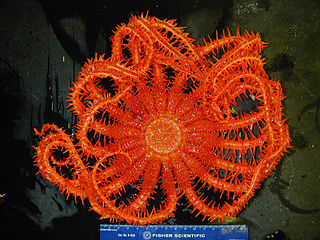
Starfish or sea stars are star-shaped echinoderms belonging to the class Asteroidea. Common usage frequently finds these names being also applied to ophiuroids, which are correctly referred to as brittle stars or basket stars. Starfish are also known as asteroids due to being in the class Asteroidea. About 1,900 species of starfish live on the seabed in all the world's oceans, from warm, tropical zones to frigid, polar regions. They are found from the intertidal zone down to abyssal depths, at 6,000 m (20,000 ft) below the surface.

Brittle stars, serpent stars, or ophiuroids are echinoderms in the class Ophiuroidea, closely related to starfish. They crawl across the sea floor using their flexible arms for locomotion. The ophiuroids generally have five long, slender, whip-like arms which may reach up to 60 cm (24 in) in length on the largest specimens.

The Valvatida are an order of starfish in the class Asteroidea, which contains 695 species in 172 genera in 17 families.

The Asterinidae are a large family of sea stars in the order Valvatida.

Astropecten is a genus of sea stars of the family Astropectinidae.

Henricia is a large genus of slender-armed sea stars belonging to the family Echinasteridae. It contains about fifty species.

Astropecten irregularis is a sea star of the family Astropectinidae. Common names include Sand sea star.

The Brisingidae are a family of starfish found only in the deep sea. They inhabit both the Atlantic and Pacific Oceans at abyssal depths, and also occur in the Southern Ocean and around Antarctica at slightly shallower depths.

Asterina gibbosa, commonly known as the starlet cushion star, is a species of starfish in the family Asterinidae. It is native to the northeastern Atlantic Ocean and the Mediterranean Sea.

Nepanthia is a genus of starfish of the family Asterinidae. Members of the genus have four to seven rays and are found in the eastern Pacific Ocean, ranging from Burma and Indonesia to Australia.

Aquilonastra burtoni is a species of small sea star from the family Asterinidae from the Red Sea which has colonised the eastern Mediterranean by Lessepsian migration through the Suez Canal, although the Mediterranean populations are clonal reproducing through fissiparous asexual reproduction. It was originally described in 1840 by the English zoologist and philatelist John Edward Gray.
Paleontology or palaeontology is the study of prehistoric life forms on Earth through the examination of plant and animal fossils. This includes the study of body fossils, tracks (ichnites), burrows, cast-off parts, fossilised feces (coprolites), palynomorphs and chemical residues. Because humans have encountered fossils for millennia, paleontology has a long history both before and after becoming formalized as a science. This article records significant discoveries and events related to paleontology that occurred or were published in the year 2020.

Starfish, or sea stars, are radially symmetrical, star-shaped organisms of the phylum Echinodermata and the class Asteroidea. Aside from their distinguishing shape, starfish are most recognized for their remarkable ability to regenerate, or regrow, arms and, in some cases, entire bodies. While most species require the central body to be intact in order to regenerate arms, a few tropical species can grow an entirely new starfish from just a portion of a severed limb. Starfish regeneration across species follows a common three-phase model and can take up to a year or longer to complete. Though regeneration is used to recover limbs eaten or removed by predators, starfish are also capable of autotomizing and regenerating limbs to evade predators and reproduce.

Disasterina is a genus of sea stars of the family Asterinidae. The genus occurs in the Indian and western Pacific Oceans.

Meridiastra is a genus of star fish in the family Asterinidae. The genus is found in the Indian and Pacific Oceans, with most records from the waters around Australia. They occur in shallow waters down to a depth of about 59 m (194 ft). Meridiastra are morphologically similar to the Atlantic genus Asterina. They are also phylogenetically close and possibly sister genera.














